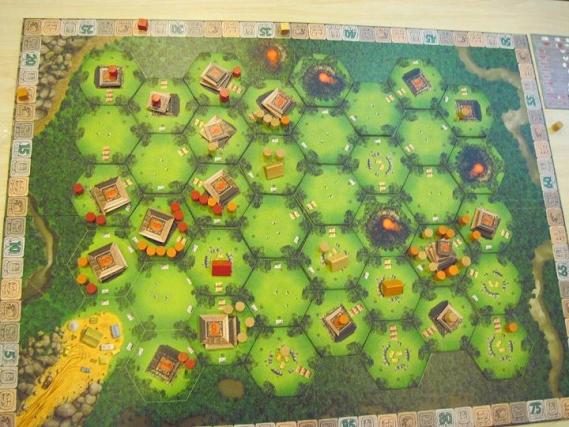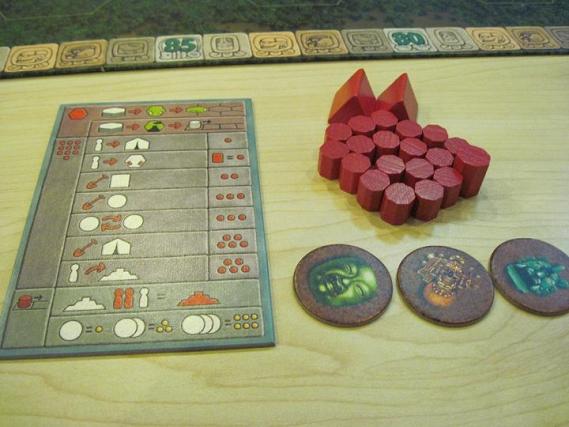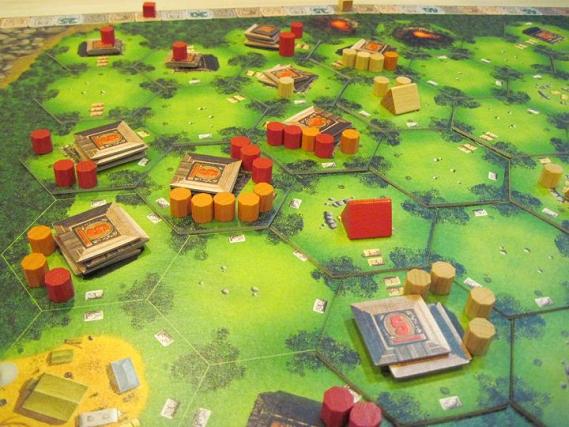
My wife agrees with me that for whatever reason I’m rather poor at games that are played on maps, especially if it’s a game that involves more than two players and includes area control elements. Tikal has all of these things, so as expected, our session mostly amounted to a competition between Sean and my wife. This doesn’t prevent me however from recognizing that it’s a pretty good middle-weight euro game and one that is a lot more beautiful than the norm.
Another plus is that Tikal has a solid theme that, unlike most euros, it does more than pay lip service to. Each player takes charge of a group of workers who are racing each other to explore the jungle. This is simulated by using large hex tiles that players draw and place onto the board to form the map of the jungle. Some of the tiles are merely empty clearings. Others represent temples and treasure troves. Players earn points for uncovering and securing temples and for recovering treasures using their workers.
The key mechanic in Tikal is that during his turn, the player gets 10 action points to spend on various actions. I’ve seen this in many computer-based strategy games before but I believe that this is the first time I’ve seen this in a boardgame. Doing anything in this game costs action points. This includes placing workers from your supply onto the board, moving them around the map, establishing new camps in the jungle, recovering treasures and so forth. You can also spend action points to “uncover” new temple levels, which means taking a level tile one number higher than the current value of the temple on placing it stacking it on top. This permanently increases the temple’s value but is thematically a bit dubious.

How you determine the cost of moving workers around is interesting as well. The terrain hex tiles have little stone icons on their edges and if you want to make a newly drawn tile accessible from a previously placed one, you have to make sure that there is at least one stone icon on either of the two sides of the joined border. This actually looks a bit weird in practice as it is quite usual to get two adjacent hexes where their edges look like open spaces but you can’t cross the border because there are no stone icons. The total number of icons on both sides of the border equal the number of action points that must be spent to move a worker from one tile to the other.
Since each player gets to place one terrain tile each turn, naturally there’s a strong incentive to make it so that it’s easy for your to workers to get to the high value temples and treasure troves and difficult for your opponents’ workers to reach them. To make movement easier, camps can be built in any clearing. Once done, new workers can enter the map on the camps or effectively teleport between two of them. Each player is limited to two camp tokens however, so it’s important to save them for truly strategic locations. One special type of tile are the volcanos of which there are three in the game. Once a player draws one of these, each player gets to play a full turn and scores at the end of his turn. Only then is the volcano placed. Since it’s a tile that is impossible to move on to, its sole purpose is to block opponents’ movements.
Most points are earned from controlling temples and you are deemed to control one if you have more workers in that hex than any other player. The temple is worth as many points as the current number shown on it. The points are scored only when a volcano is drawn as detailed above or at the end of the game, meaning that scoring happens only four times in the game. The other source of points is collecting sets of treasure. One item all by itself is worth only 1 point but a full set of three is worth 6 points. A cool rule is that a player can spend action points to force another player to trade treasures with him except for items of which he already has two or more of. In effect, this minimizes the luck factor of getting sets of the same treasure and ensures that recovering them will always be advantageous.

Finally, players can lock down a temple by placing a worker on top of it to act as a guard. To do this, he must already have a majority of workers at that temple and permanently loses all other workers at that location. Sean used this rule to good effect against me in our game. I had opened up a new area and saw that it would be costly for the other players to move their workers there, so I dawdled about getting control of some temples there. However, Sean sent in a worker to an empty temple and immediately locked it down since no other worker was around. It’s a good thing you’re only allowed to do this twice in the whole game or else it would only be about racing towards empty temples and putting workers to guard them.
One variant that Sean talked about involves using victory points to auction for the terrain tiles but given how little randomness there is in Tikal already, that hardly seems necessary. As a game of completely open information with fixed action point allocations each turn, I could easily see this leading to analysis paralysis, especially if you really want to work how best to place your terrain tiles. I’d say that in general this is a game of seeing your opponents’ moves and tactically reacting to it, so there’s isn’t much of a pressing need for long-term strategy.
Anyway, I can’t see myself ever being any good at this but I do admire its design. None of the mechanics are particularly novel, but they come together very well here. I also like the look of the board and the terrain tiles. It really looks like you’re uncovering more and more of the jungle as the game progresses even if the stone icon system can make the usable paths through the jungle look very weird indeed.
One Response to “Tikal”
Trackbacks
Leave a Reply